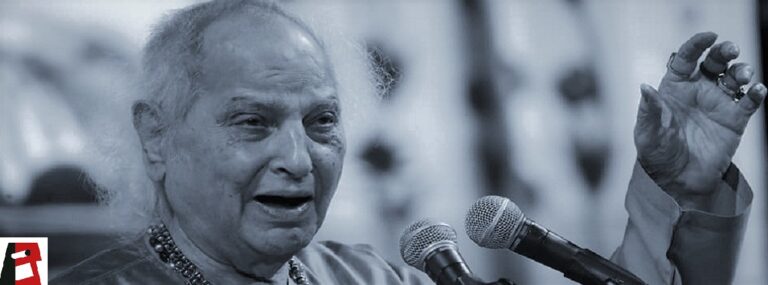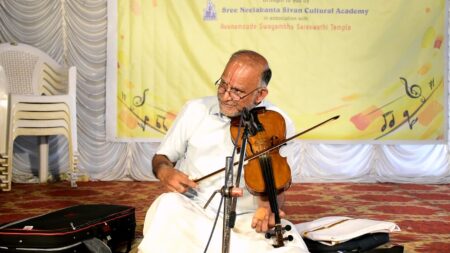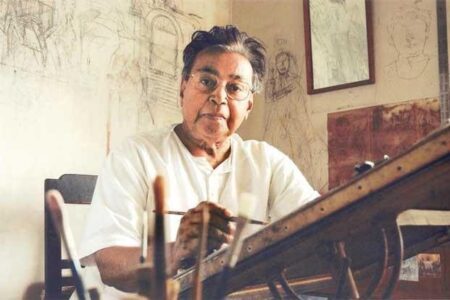From crying out for Allah to acting as god for his fans, the iconic musician was a curious conflux of thoughts and deeds.
The reposeful treatment of the ragas contrasted gloriously with the garrulous talk off the dais. Notwithstanding his recurrent comments about a high spirituality quotient in Indian music, there prevailed not-so-hushed rumours around the maestro’s liaisons with women. The banner of Mewati gharana he aloft like never before in Hindustani classical was a delightful blend of certain schools in the idiom.
Pandit Jasraj was a bundle of beautiful contradictions. His eight-decade career also scripted a particularly pleasing juxtaposition: a penury-riddled childhood vis-à-vis an immensely wealthy second half of life. The dusty village he grew as a kid upcountry was a far cry from the manicured New Jersey where the end came following a cardiac arrest.
The legend was 90 when he breathed his last at his house in the Mid-Atlantic state of the US in the early hours of August 17. Jasraj had been staying overseas all through the Covid-19 months, but had never quite locked down. Even last week, the guru spoke highly of Bollywood songs and taught classical on Skype.
Jasraj was conservative at no point in time. If anything, he had a penchant for eclecticism. This did earn him criticism. At least initially. Even when he was gaining stardom around the second half of the 20th century, gharanas largely remained islands of musical individuality. There did exist streaks of hybridity, but they were born out of sociohistorical reasons — and rarely individual borrowings.
Prudent assimilator
If Jasraj’s khayals carried the soulful placidity of Amir Khan (1912-74), it was no secret that the Indore gharana ustad had a telling influence on the youngster who went on to be hailed as Sangeet Martand. The other strains Jasraj absorbed out of sheer pursuit of aesthetics were Benares (Omkar Nath Thakur) and Patiala (Bade Ghulam Ali Khan).
Undeterred by disapprovals from scholars, Jasraj incorporated elements far beyond the ethos of his native region in present-day Haryana. In any case, Mewati gharana itself has a 19th-century link to exponents in places that are in Madhya Pradesh now.
Not to be forgotten is Jasraj’s initial tryst with the tabla. In early teenage years, he was a percussionist. That he was good in the twin hand-drums is evident from the episode that, paradoxically, paved his exit as a tabla player.
It happened when Jasraj was 15 and India was two years short of partition. In 1945, he played in Lahore, accompanying the prodigious Kumar Gandharva, four years younger. An experimental passage from the vocalist wasn’t to the taste of an expert listener, who chided Jasraj subsequently for ‘siding with the sacrilege’. Enough is enough, the teenager decided, already unhappy with the insufficient attention the tabla enjoyed those days.
Already enamoured by the renditions by Begum Akhtar (1914-74) who excelled in the streams of ghazal, thumri and dadra, he plunged into vocal. The boy’s elder brother, Pandit Maniram, was an eminent musician — and now his tutor. So was another sibling, Pratap Narayan. Jasraj’s vocal debut, at the age of 22, was transnational: at the Nepal king’s court in Kathmandu.
Wanderer settles
The family led a largely peripatetic life in Jasraj’s formative years defined by the untimely death of his father (when the boy was only four years old). The Brahmin household first shifted from Pilli Mandori southward to Hyderabad, then to Sanand off Ahmedabad and, diametrically opposite, to Calcutta in 1946. The eastern metropolis proved to enhance Jasraj’s capacity, giving him chances to sing at the AIR studios.
Eventually, the master made Mumbai his home, marrying in 1962, two years after meeting his future wife in the western city. Illustrious filmmaker V Shantaram’s daughter Madhura was Jasraj’s life partner.
The charismatic vocalist had a legion of admirers that included ladies in a big way. In that, Jasraj was much like G N Balasubramaniam, the trendsetter Carnatic icon (1910-65), whose physical presence was as striking as his vocal brilliance. That used to be the saga till the end for both. Often, Jasraj would walk on to the stage amid spirited chants of ‘Jai ho’ from the audience. In response, he would raise hands in a blessing gesture.
Mangalam Bhagwan Vishnuh, Mangalam Garudadhwajah Mangalam Pundari Kakshah, Mangalaya Tano Harih
The two-liner in Sanskrit typically marked the start of a Jasraj concert. It built the ambience of a detailed aalap. The flowy hairs looked as silken as the clothes and ostentatious as the gold ornaments. The fingers would run along the strings of the surmandal held close to the chest. A couple of disciples sitting behind would assist, strumming the tanpura. The demigod status never faded even while Jasraj’s last leg of career tended to stuff semi-classical items in a big way.
Well into the autumn of his life, Jasraj continued to stumble upon unexpected musical discoveries in his renditions. The surprise would manifest as a sudden grin, the eyes going shy as if apologetic about an unwitting mischief. The master was in perpetual search for magical gems.
Sreevalsan Thiyyadi is a senior journalist and arts enthusiast




